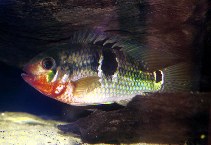| Family: |
Cichlidae (Cichlids), subfamily: Cichlasomatinae |
| Max. size: |
19.2 cm TL (male/unsexed); max.weight: 157.0 g |
| Environment: |
benthopelagic; freshwater; pH range: 4.90000009536743 - 7.5; dH range: 1 - 13.5 |
| Distribution: |
South America: widely distributed in the Amazon River basin in Peru, Colombia, Ecuador, Brazil and Bolivia. Also in the Tocantins and Parnaíba rivers, French Guiana, Suriname, Guyana, and in the Orinoco River basin of Venezuela and Colombia. |
| Diagnosis: |
|
| Biology: |
One of the most colorful species of the genus, especially during its reproductive period. Frequently occurs in zones with little current and over a substrate covered with vegetal debris (Ref. 27188). Caught frequently but not abundantly in most varied biotopes- in small creeks and flooded zones with clear, shallow and slow flowing water. Feeds primarily on insects, secondarily on fishes and plants. Very territorial. During reproduction, males attain a deeper coloration. About 1,000 eggs are released during spawning. Spawning takes place on stone or wood. Parents take care of juveniles (Ref. 35237). Maximum length 25 cm TL (Ref. 1672). |
| IUCN Red List Status: |
Least Concern (LC); Date assessed: 28 October 2020 Ref. (130435)
|
| Threat to humans: |
harmless |
Source and more info: www.fishbase.org. For personal, classroom, and other internal use only. Not for publication.
